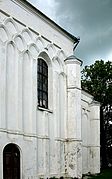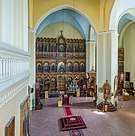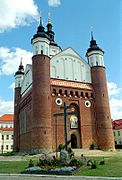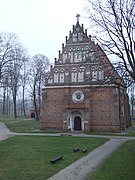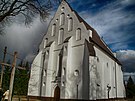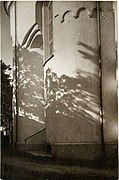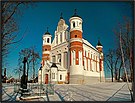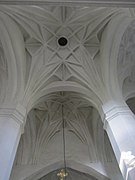Belarusian Gothic
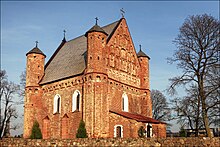
Belarusian Gothic (Belarusian беларуская готыка [belaruskaya hotyka]) is the architectural style of ecclesiastical buildings constructed during the 15th and 16th centuries in parts of modern Belarus, Lithuania and eastern Poland. The term is disputed and considered a product of Belarusian nationalism, and used by Belarusian historians only. It describes the fact that in the Slavic regions of the Grand Duchy of Lithuania, many of them forming present day Belarus, some Gothic buildings were built for Eastern Orthodox congregations and landlords. Although these buildings have features typical of Gothic architecture such as lofty towers, flying buttresses, pointed arches and vaulted ceilings, they also contain elements not typically considered Gothic by Central and Western European standards.
History
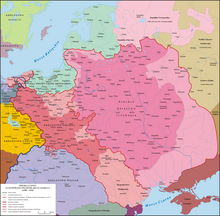
With the baptism of the Grand Prince Vladimir the Great and the "Christianization" of the Kievan Rus, the architecture of the region became heavily influenced by Byzantine architecture.
During the 13th century and the first decades of the 14th century, the principalities in present-day Belarus are eventually subjugated by the Grand Duchy of Lithuania, a pagan state which was fighting against expansion of Teutonic Order. The Grand Duchy became a dominant power in the 14th century, featuring a developed nobility. Lithuanian rulers started to build Brick Gothic castles and established churches for their Catholic citizens, which were also constructed in Brick Gothic. Contacts with the Teutonic order and Europe allowed to hire experienced architects. Old Chancery Slavonic was used for legal code and documentation.
After the Union of Krėva in 1386, the countries of Poland and Lithuania were united with personal union, which caused a christianization of Lithuania and an increase in communication in western and southern Europe. Christianization of Lithuania led to more intensive expansion of Western culture and namely, Gothic into Orthodox lands.
During this period, the Gothic style came to the Slavic regions. In central and southern Europe however, it was already being displaced by Renaissance architecture.
In 1346 the Orthodox Cathedral of the Theotokos, Vilnius[1] in Vilnius, was constructed, before the Lithuanian state had become Catholic. (see history of Roman Catholic Lithuania).
- Examples
-
Cathedral of Ss. Boris and Gleb,[2] Navahrudak (1519–1630), southern façade
-
Cathedral interior (1930 photo)
-
The 16th-century Mir Castle
-
Church of Supraśl Orthodox Monastery, Poland
-
Church in Muravanka
Architecture
Belarusian Gothic combines Byzantine, Gothic, and Renaissance architecture. Although some buildings have a north-German Brick Gothic design, others are plastered. Window arches are primarily pointed, but blind arcades and Lombard bands have round arches. Most churches have rib vaults, but there are also simple massive trunks such as those in Romanesque and Byzantine architecture. Most were fortified, with a short nave and a small tower at each corner; others have an ordinary, high, Western bell tower.[5]
References
- ^ Description of the Cathedral of the Theotokos - in Russian
- ^ www.radzima.org (Belarusian portal on monuments in Belarus, Lithuania and Podlachia) Царква Святых Барыса й Глеба|Навагрудак (description of Boris-and-Gleb-Church in Belarusian)
- ^ Roman Aranazy, Dzieje rezydencji na dawnych kresach Rzeczypospolite (Residences in former districts of the (Polish) Republic today (in Polish), 1993, S. 209, Hniezna
- ^ radzima.org – touristic presentation of Hnezna
- ^ "Exploring Castles".
Sources
- Nigel Roberts, Belarus, p. 185 (google books)
- Rainer Lindner, Historiker und Herrschaft: Nationsbildung und Geschichtspolitik in Weißrußland im 19. Und 20. Jahrhundert, Verlag Oldenbourg 1999, ISBN 3-486-56455-2, S. 256, II. Nation und Geschichte im Stalinismus → 3. Rivalität der Mythen (Nation-building and policy of history in Belarus in the 19th & 20th centuries) – in German
- Archives of Belarus, Church Architecture
- Беларуская готыка ў пабудове культавых будынкаў XV-XVI стст. – Belarusian Gothic in religious buildings of the 15th and 16th centuries (in Belarusian, very much illustrated)

